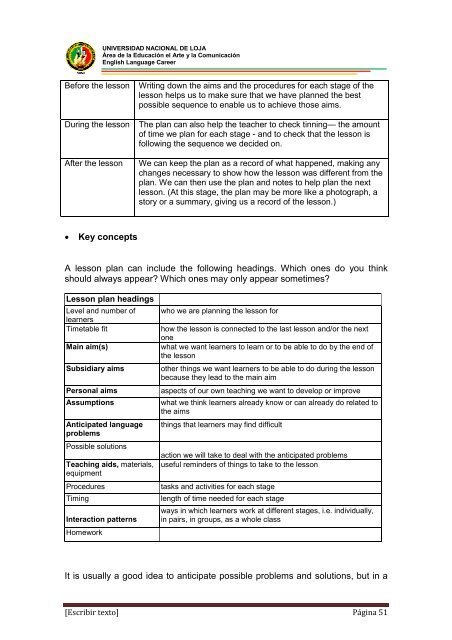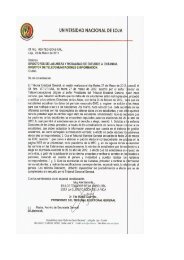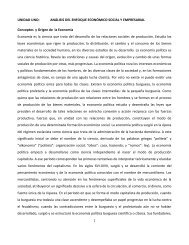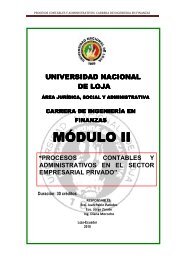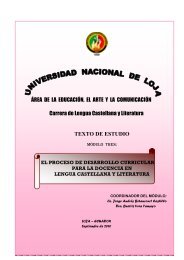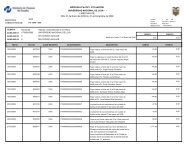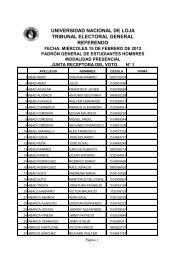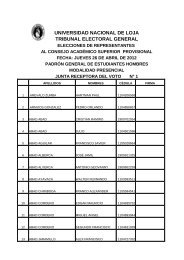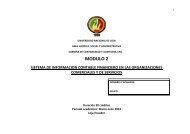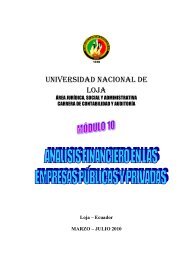module 5 planning of the english language teaching-learning process
module 5 planning of the english language teaching-learning process
module 5 planning of the english language teaching-learning process
Create successful ePaper yourself
Turn your PDF publications into a flip-book with our unique Google optimized e-Paper software.
UNIVERSIDAD NACIONAL DE LOJA<br />
Área de la Educación el Arte y la Comunicación<br />
English Language Career<br />
Before <strong>the</strong> lesson<br />
During <strong>the</strong> lesson<br />
After <strong>the</strong> lesson<br />
Writing down <strong>the</strong> aims and <strong>the</strong> procedures for each stage <strong>of</strong> <strong>the</strong><br />
lesson helps us to make sure that we have planned <strong>the</strong> best<br />
possible sequence to enable us to achieve those aims.<br />
The plan can also help <strong>the</strong> teacher to check tinning— <strong>the</strong> amount<br />
<strong>of</strong> time we plan for each stage - and to check that <strong>the</strong> lesson is<br />
following <strong>the</strong> sequence we decided on.<br />
We can keep <strong>the</strong> plan as a record <strong>of</strong> what happened, making any<br />
changes necessary to show how <strong>the</strong> lesson was different from <strong>the</strong><br />
plan. We can <strong>the</strong>n use <strong>the</strong> plan and notes to help plan <strong>the</strong> next<br />
lesson. (At this stage, <strong>the</strong> plan may be more like a photograph, a<br />
story or a summary, giving us a record <strong>of</strong> <strong>the</strong> lesson.)<br />
• Key concepts<br />
A lesson plan can include <strong>the</strong> following headings. Which ones do you think<br />
should always appear? Which ones may only appear sometimes?<br />
Lesson plan headings<br />
Level and number <strong>of</strong><br />
learners<br />
Timetable fit<br />
Main aim(s)<br />
Subsidiary aims<br />
Personal aims<br />
Assumptions<br />
Anticipated <strong>language</strong><br />
problems<br />
Possible solutions<br />
Teaching aids, materials,<br />
equipment<br />
Procedures<br />
Timing<br />
Interaction patterns<br />
Homework<br />
who we are <strong>planning</strong> <strong>the</strong> lesson for<br />
how <strong>the</strong> lesson is connected to <strong>the</strong> last lesson and/or <strong>the</strong> next<br />
one<br />
what we want learners to learn or to be able to do by <strong>the</strong> end <strong>of</strong><br />
<strong>the</strong> lesson<br />
o<strong>the</strong>r things we want learners to be able to do during <strong>the</strong> lesson<br />
because <strong>the</strong>y lead to <strong>the</strong> main aim<br />
aspects <strong>of</strong> our own <strong>teaching</strong> we want to develop or improve<br />
what we think learners already know or can already do related to<br />
<strong>the</strong> aims<br />
things that learners may find difficult<br />
action we will take to deal with <strong>the</strong> anticipated problems<br />
useful reminders <strong>of</strong> things to take to <strong>the</strong> lesson<br />
tasks and activities for each stage<br />
length <strong>of</strong> time needed for each stage<br />
ways in which learners work at different stages, i.e. individually,<br />
in pairs, in groups, as a whole class<br />
It is usually a good idea to anticipate possible problems and solutions, but in a<br />
[Escribir texto] Página 51


